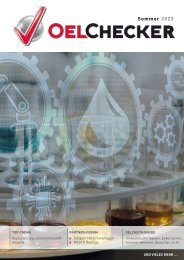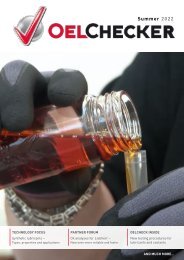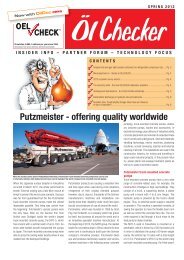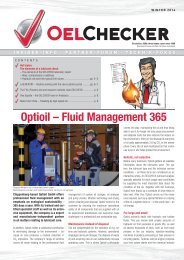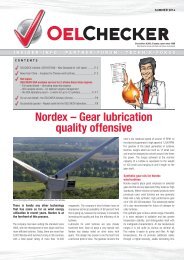OELCHECKER - Summer 2012
> Prokon wind turbines – optimum service and secure earnings > OELCHECK laboratory in the "workbench of the world" domain > The rappers from the OELCHECK alpine pastures > Optimised technology and perfect service for gas engines – August Storm > Hot Topics: > Viscosity – the single most important physical characteristic of any oil > Question time: Limit values > and much more...
> Prokon wind turbines – optimum service and secure earnings
> OELCHECK laboratory in the "workbench of the world" domain
> The rappers from the OELCHECK alpine pastures
> Optimised technology and perfect service for gas engines – August Storm
> Hot Topics:
> Viscosity – the single most important physical characteristic of any oil
> Question time: Limit values
> and much more...
Create successful ePaper yourself
Turn your PDF publications into a flip-book with our unique Google optimized e-Paper software.
Industrial oils<br />
viscosity at 40°C (instead of 50°C in Europe or<br />
100°F in USA).<br />
A comparison of viscosities according to ISO VG<br />
(at 40°C) and SAE (at 100°C or for winter oils in<br />
the bottom temperature range) is limited since the<br />
thresholds of viscosity classes are not congruent. It<br />
is particularly difficult in the case of multigrade oils.<br />
ISO viscosity groups for industrial oils<br />
The system covers 18 viscosity ranges. In accordance<br />
with DIN 51 519, the minimum and maximum<br />
kinematic viscosity for each class is defined<br />
in mm²/s at 40°C. The thresholds for each class<br />
account for a ± 10% deviation from the midpoint<br />
viscosity. No VI or second viscosity is provided.<br />
Therefore, the ISO VG cannot make any claims<br />
about viscosity-temperature behaviour. With the<br />
exception of multigrade hydraulic oils, specified in<br />
DIN 51524-3, the multigrade characteristic is of<br />
secondary importance in the field of industry not<br />
least because industrial machines are operated at<br />
a constant temperature.<br />
ISO VG<br />
Midpoint viscosity<br />
mm²/s 40°C<br />
Kin. viscosity min.<br />
mm²/s 40°C<br />
Kin. viscosity max.<br />
mm²/s 40°C<br />
2 2.2 1.98 2.42<br />
3 3.2 2.88 6.52<br />
5 4.6 4.14 5.06<br />
7 6.8 6.12 7.48<br />
10 10 9.00 11.0<br />
15 15 13.5 16.5<br />
22 22 19.8 24.2<br />
32 32 28.8 35.2<br />
46 46 41.4 50.6<br />
68 68 61.2 74.8<br />
100 100 90.0 110<br />
150 150 135 165<br />
220 220 198 242<br />
320 320 288 352<br />
460 460 414 506<br />
680 680 612 748<br />
1,000 1,000 900 1,100<br />
1,500 1,500 1,350 1,650<br />
SAE classes for automotive oils<br />
Previously, engine oils were changed according to<br />
the time of year. In accordance with SAE J-300/<br />
DIN 51511, oils for the automotive industry still<br />
have a W in their name if they are designed for use<br />
at low temperatures.<br />
Thanks to appropriate base oils and the addition<br />
of modern viscosity index improvers, multigrade<br />
oils such as 5W-30 meet the viscosity class<br />
criteria of a W-oil (with the required low-temperature<br />
viscosity) as well as a high-temperature<br />
requirement (with an indication of minimum viscosity<br />
at 100°C).<br />
Automotive engines<br />
SAE<br />
Kin. viscosity min.<br />
mm²/s 100°C<br />
Kin. viscosity max.<br />
mm²/s 100°C<br />
0W 3.8 -<br />
5W 3.8 -<br />
10W 4.1 -<br />
15W 5.6 -<br />
20W 5.6 -<br />
25W 9.3 -<br />
20 5.6




